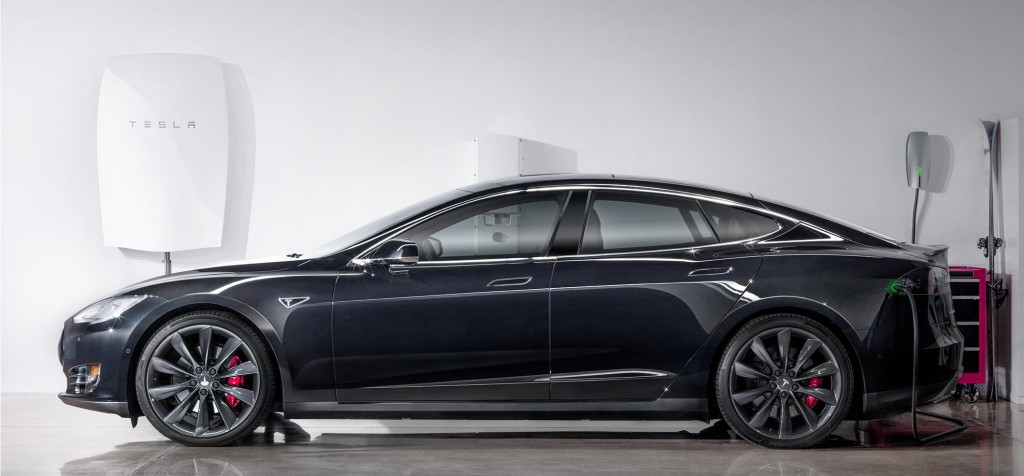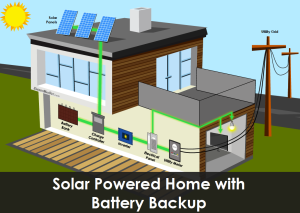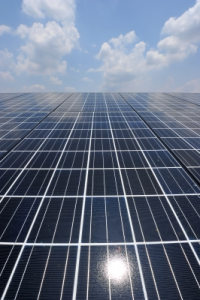Besides the energy savings, one of the biggest benefits for photovoltaic solar panels is the fact that they often create more energy than your home uses, especially during the day when you’re not home. However, selling electricity to the power company by feeding excess back to the grid may not be the most cost effective way to go about using solar power for your home. In fact, it may be a better deal, overall, to store your excess power in an on-grid battery backup…but, it depends…
Why? The electric company buys power back from you at a lower rate than it sells power to you. So, if you sell all of the excess power your home collects during the day and then run short at night, you’ll end up buying the same amount of power that you could have had for free. However, battery backup systems for your solar panels are not cheap, and there are some cons along with the pros. Fortunately, companies are investing astronomical amounts of money into mass producing their battery backup systems to dramatically reduce the costs. Elon Musk’s, Tesla Powerwall is a product that’s received a lot of attention with the hope of making battery backup systems affordable for everyone. Let’s explore your best options.
On-Grid or Off-Grid?
Basically, if you choose to power your home with solar panels and a battery backup system, you have a couple of options. You can choose an on-grid system with a tie-in to the power grid. When there’s enough solar power, your home runs directly off of power collected by your solar panels.
With a battery backup and grid tie-in set-up, when power from your solar panels isn’t sufficient, your home will use power that’s been stored in the battery backup system. As a last resort, when that isn’t enough, your home will use grid power.
Your other option is to choose to live off-grid, solely on solar power and your battery backup. In this case you’ll have no tie-in with the grid. If you have sufficient solar power and battery storage capacity, this is ideal. But, if you do not, you could find yourself in an emergency situation with no power and no way to patch into the grid.
Yep…let’s get a Battery Backup System!
Depending on how you set your system up, you can run your battery backup system as a UPS (uninterrupted power supply) or you can use it to power your home at night when the sun is no longer shining and your solar panels aren’t producing energy. As a UPS, you can set it to power certain appliances in your home to keep them running in a power outage. For example, if there’s a bad storm that lasts several days and the power is out in your area, you can still maintain power to your refrigerator, some lights, computer, or whatever appliances you feel are essential.
If your battery backup is fully charged, you can still send electric power back to the grid for credits toward your power bill. If you only use solar power and your battery backup most of the time, you’ll get a fast return on your investment in the battery backup system and you’ll be producing environmentally friendly energy.
Nope…let’s think about it a little more…
However, battery backup systems are not cheap. If you’re not planning on living off the grid or staying with the same solar power system for some time, this system could cost you a great deal of money without saving you a whole lot. To really make it work for you, you need to have the money for the upfront investment and the time to make that money back.
You also have to keep your battery backup system maintained, or it won’t function properly. If you’re not prepared to do this, it’s really a waste of time. Also, because battery backups decrease the amount of power you feed back into the grid, they do decrease the credits you get from the power company. Again, they can pay off in the long run, but you have to give the system time.
Converting to an on-grid solar power system without battery backup generally involves an investment of about $16,000-$40,000, depending on the size of your home and how much energy you need. Off-grid solar power typically costs $20,000-$52,000, though you have to keep in mind that you’ll never have a power bill when you’re not connected to the grid. Finally, on-grid solar power with a battery backup is usually about $19,000-$48,000. Again, it’s a game of investment versus payout. If you plan to stay at your current home for many years, a battery backup system will pay for itself and is worth purchasing.
You’ll also like:
Questions about Solar That You Forgot to Ask
Cube from the Future could Power Everything
How to Make Money from the Solar Energy Boom




Leave a Reply